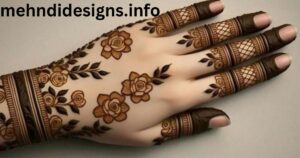Simple back hand mehndi design is trending fast, especially among young women in the USA who love creative body art. This type of easy henna for girls focuses on beauty with minimal effort. Whether you’re preparing for a wedding, Eid, Diwali, or just a weekend event, choosing a minimal mehndi design can instantly add elegance to your look. These designs are perfect for beginners and don’t need professional help. From floral mehndi pattern for hand to back hand Arabic mehndi, there’s something for everyone. Unlike full bridal styles, these are often quick and stylish, making them ideal for those seeking a back hand bridal mehndi (light style). If you’re searching for a step-by-step back hand mehndi design, this guide covers everything to get you started beautifully and easily.

back hand
mehndi
1. Understanding Mehndi Art: An Introduction
Mehndi art for hand backside is more than decoration. It’s a form of expression passed down through generations. Using natural henna paste, it stains the skin with beautiful reddish-brown tones. In the USA, people love it because it’s painless, chemical-free, and temporary.
You don’t need to be a professional to create a beginner-friendly mehndi design. All you need is a quick mehndi tutorial, some practice, and the right tools. Whether you want to try no tools mehndi art or use cones, this form of body art is fun and creative.
2. A Glimpse into the History and Cultural Significance
Mehndi has deep roots in Indian, Pakistani, Arab, and African cultures. It was always used for celebrations, especially weddings and festivals. The idea was to beautify the body, bring good luck, and mark joyful events.
Now, it’s popular globally. In the USA, festival mehndi for back hand is common during events like Diwali, Eid, and even music festivals. It has become a mix of traditional patterns and modern designs, like back hand Arabic mehndi or floral mehndi pattern for hand.
3. Essential Tools and Ingredients for Perfect Mehndi
To get started with mehndi, you’ll need a few basic things: fresh henna cone, tissue, lemon-sugar mixture, and a plastic sheet to rest your hand. Some people use stencils, but with a little practice, you won’t need them.
Here’s a simple table to understand what you need:
| Tool/Ingredient | Purpose |
|---|---|
| Henna Cone | Drawing designs |
| Tissue or Cotton | Cleaning mistakes |
| Lemon-Sugar Mixture | Makes the stain darker |
| Clear Tape | Helps steady your hand |
| Plastic Sheet | Keeps surface clean |
Using these tools, you can start your journey to elegant mehndi for beginners with confidence.
4. Preparing for the Perfect Mehndi Design
Clean, dry skin is important. Wash your hands with soap, and avoid lotion before applying mehndi. This makes the color deeper and longer-lasting. For best results, exfoliate your hand the night before.
Also, test the henna on a small skin area to avoid allergies. This is especially important in the USA, where people may not be used to henna products. After testing, you can begin your journey into simple henna design for back side of hand.
5. Design Planning: From Ideas to Blueprint
Start with a rough idea. Decide if you want a minimal mehndi design or a detailed one. Many beginners prefer easy henna for girls that include dots, flowers, and lines. You can get ideas from social media, especially Instagram or Pinterest.
If you’re not sure where to begin, sketch your pattern lightly using an eyeliner pencil. You can plan your back hand bridal mehndi (light style) this way before using henna.
6. Step-by-Step Guide to Creating Trendy Patterns
Let’s walk through a step-by-step back hand mehndi design. Start at the wrist or the finger. Draw a flower, then add leaves and vines. Then, fill the spaces with small curves and dots.
Want something simpler? Try a quick mehndi design with a single large flower on the back hand, and add small lines around it. This method helps create a stylish mehndi design for back hand in just 10 minutes.
7. Execution Techniques: Tips from the Pros
Hold the cone like a pen. Practice drawing lines on paper before trying on your skin. Always keep tissues nearby in case you make a mistake.
To get dark stains, leave the paste on for at least 5–6 hours. Avoid water and soap during this time. These small tricks make a big difference, especially for back hand mehndi ideas that need to pop.
8. Trending Full-Hand Mehndi Designs for Every Occasion
Some people want full-hand designs. Even then, you can keep it simple. Go for floral mehndi pattern for hand, or use back hand Arabic mehndi with vines and petals.
In the USA, many brides now prefer back hand bridal mehndi (light style) to keep it classy and manageable. For casual wear, try a small flower at the center and let it branch out with curves.
9. Aftercare for Darker, Longer-Lasting Stains
Good aftercare is the key. Apply lemon-sugar liquid once the paste dries. Avoid washing it off with water. Instead, scrape it off and keep the area warm.
The USA climate is mostly dry, so you can wrap your hand in cling film or plastic to lock in heat. That makes your mehndi design for small functions stand out with a darker stain.
Final Thoughts
Creating a simple back hand mehndi design doesn’t need expert skills. Anyone can do it with a little planning, the right tools, and inspiration. From a beginner-friendly mehndi design to a trending mehndi styles, your hand becomes your canvas.
Try different styles, practice often, and you’ll soon be creating your own signature mehndi art for hand backside.
Faqs
Q1: Which Mehendi design is trending now?
A: Minimalist and geometric mehendi designs with clean lines and negative space are currently trending.
Q2: What is the name of the henna hand art?
A: The art is called Mehndi in South Asia and Henna in Western countries.
Q3: How to put Mehndi easily?
A: Use a pre-filled henna cone, apply on clean dry skin, let it dry, and wrap or seal for deeper color.
Q4: Who is the best Mehndi designer in the world?
A: Azra Khamissa is widely recognized for her modern and stylish henna art internationally.
Q5: Which mehndi is best for hands?
Natural, chemical-free organic henna cones are best for hands—they give a deep color and are skin-friendly.

